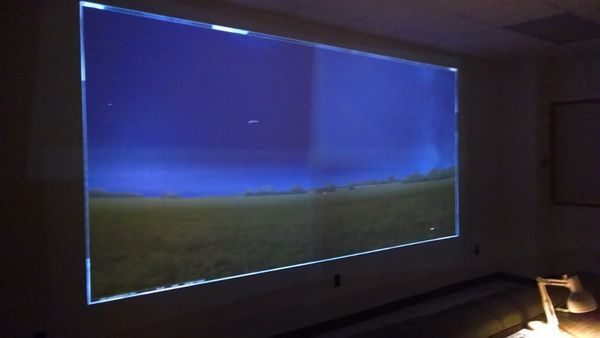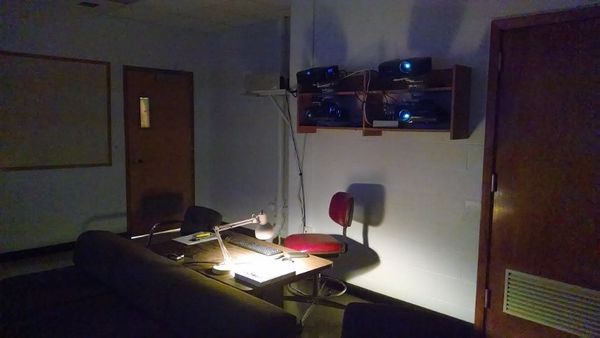Immersive Video Wall
The teaching astronomy lab on the University of Louisville's Belknap campus has a room dedicated to immersive video. It features 4 theater quality projectors creating a blended high definition (HD) quality screen that students can view interactively. The projectors are driven by a state-of-the-art graphical display computer system running Vioso Anyblend edge blending software on a Windows operating system.
This page is for the use of teaching assistants in the lab, and for students and others who may be interested in the technology.

How to use the room
For students this room is very easy to use. The instructor and teaching assistants will have it ready for you, and the application you will use for your work in that lab will be running. However, here are some suggestions, and a few requests. First, the requests:
- Use only the application which is needed for this lab. It will be "full screen". (If not, ask for help.)
- Do not make any adjustments or changes to the projectors, or to run any other windows application on the system. We have it optimized for this one task, and the next group will need this application running.
- Do not turn off the projectors. It takes a while for them to cool down to allow turning them back on. The assistants will do this when it is appropriate.
And then the suggestions:
- It helps to keep a low level desk light on. This reduces the appearance of a blending artifact in the black background. (We are working to remove it.)
- If the screen is dark, try moving the mouse. It may have timed out. Or, if the projectors are not running ask the assistant for help. Please do not try to start them yourself.
- There is no monitor! The wall is the screen. Interact with the display using the mouse and keyboard.
- Have one of the group "drive" seated at the desk and the others interact with the driver from better seats. You can change roles, of course.
- The best view is from the front seats, close to the screen. With Stellarium displaying the horizon across the wall, the sky will be scaled almost as you would see it outside.
- When you are finished, please reset Stellarium to Louisville at the current time.

Running Stellarium
The room is used to run a day/night sky simulation using Stellarium. This software is also on the other computers in the lab, but here it is more immersive, and creates an experience closer to what you would see in the real sky. We have Stellarium set up to be located in Louisville, Kentucky. If you change the location, before you leave please reset it to Louisville and the current date and time.
Stellarium should run covering the entire screen. However, in order to have it work with this hardware, we have to "stretch" the window to cover the screen. The instructor and assistants should have this already set this way. Do not use it with the small window because that defeats the purpose of the immersive wall. However, if Stellarium is not running it is easy to get it going:
- Double click on the Stellarium icon on the upper right of the Windows desktop.
- Click on the lower right corner and drag it to cover the desktop.
- Recenter and drag as needed. You should only see Stellarium when it is set correctly, as in the picture at the top of this page.
Stellarium has two menus that are hidden on the lower left bottom and lower left edge of the window. Slowly slide the mouse down at the left side and the lower menu will pop up. You can experiment with the various buttons. The critical ones are those on the right that control time and the rate that time goes by. One of them will reset to the current time, and the others will go forward, backward, or change how fast time goes by. When you are finished, please leave the softare running in "real time", located in Louisville.
You interact with the display by moving the mouse around. You can identify objects, look in different directions, and zoom in and out with the mouse. Just try the buttons and you'll learn quickly how to control what you see.
Instructions for the teaching assistants
If you have a group using the system, turn the projectors on at the beginning of the class. Turn them off with the students are finished. The lamp lifetime is limited and it's best not to run them when they are not being used. However, it does take a few minutes for them to come up to working brightness, and there is a delay to restart after they have been turned off.
To turn the projectors on or off use only the remote control. It should be kept on the lower left shelf so that it is not out for students to inadvertently use. Remember that once the projectors are powered down, there is about a 15 minute delay before you can power them up again.
When you point the control at the wall (not at the projectors) it will talk to all of them at once. Press "Power" once and you should see four identical messages on the screen. If necessary, you can use the control with one projector at a time but you have to carefully shield the IR signal so it does not scatter. One way is to hold the control in front if the sensor window on the projector (a small rectangle close to the lens) and shield it from the room with your hand. This one-at-a-time operation is usually not necessary.
- Do not alter any other projector settings. They are optimized for this use.
- Do not operate the projectors from the control panel on the projector. You may accidently disturb the alignment.
Ordinarily we would run one application for the labs during the week, and cycle that from time to time. The ones that are presently available are:
- Stellarium
- Celestia
- Partiview
- Movie player: Namibian Sky
and we have activities built around them. Please do not use the system for any other software. Start the software for the students if it is not running.
When something is wrong
We are still learning how to use the system, and how to adjust it so it works well for our software. There's no doubt things will go wrong. When you have a problem and the solution is not obvious, it's best to call for help so that a long reboot or realignment is not necessary.
Common problems and quick solutions:
Stellarium (or Celestia or Partiview or the movie) is not running
As long as the desktop projected on the wall looks like a nice rectangle, most likely someone has exited the program. You might first check that it has not been minimized. The Windows toolbar is hidden at the bottom of the screen, so slide the mouse down and it will pop up. If an application has been minimized it will show on the toolbar. Only one application -- the Vioso manager -- runs in background all the time. Do not disturb that one!
Double click on the icon for your desired application and it should open in a normal-sized window. Use the mouse by clicking on sides or corners to expand and center this window of the entire desktop. An example is the wall view of Stellarium at the top of this page.
The wall is dark
One obvious possibility is that the projectors are not running. You can look at the lenses and if they are on you'll see some light there. Also, with room lights off, a dark screen is not totally black but has a gray cast and there's a cross where the projectors overlap.
If the projectors are on, then the computer may have gone into a screen saver mode. Try moving the mouse, or pressing the spacebar.
There is a blue screen that says Vioso where there should be desktop
This should not happen! But, sometimes someone may have changed the source setting for a projector by pressing a key on the hand control. The top two projectors are HDM1, the bottom two are HDM2. To change only one projector and not all, you have to carefully shield the hand control's IR emitter so it is seen only by that projector. Avoid this awkward circumstance by never changing the settings, and by keeping the hand control away from exploring hands.
The display is not blended. Its outer edges are jagged and it looks unusable.
The most likely event is that someone has altered a setting in the Vioso manager. It may be unrecoverable without a total reset, which will require the instructor or a techinician unless you have been taught how to do it. It also takes about 45 minutes, so in this state the system probably cannot be restored for students to use for the current lab. However, there is one thing you can try. Close Stellarium or whatever application you have running, and run the mouse down to bring up the hidden Windows toolbar. Check for the Vioso minimized application on the toolbar, and if it is there, click on it. If it is not there, there is nothing you can do.
The Vioso application runs in the lower right of the screen. You'll see a large "Hook" button. This control toggles the state of the desktop display from running unblended to running blended on the wall. You can try to press Hook if the display appears to be unblended. Vioso may then come back to its healthy state. If it doesn't then call for technical assistance because the problem is not so simple.
There is a Windows login prompt and the screen is not blended.
There has been a power outage. The settings have been lost and the system has to be restarted by the instructor or a technician.
There is a black screen in the upper right projector that says "Insert boot media".
There has been a power outage. The system tried to reboot unsuccessfully and is stalled. It will have to be restarted by the instructor. Turn off the main power switch on the lower outside back corner of the computer (high on the wall to the left of the projectors). Turn off the projectors with the controller on/off button. Call for help.

